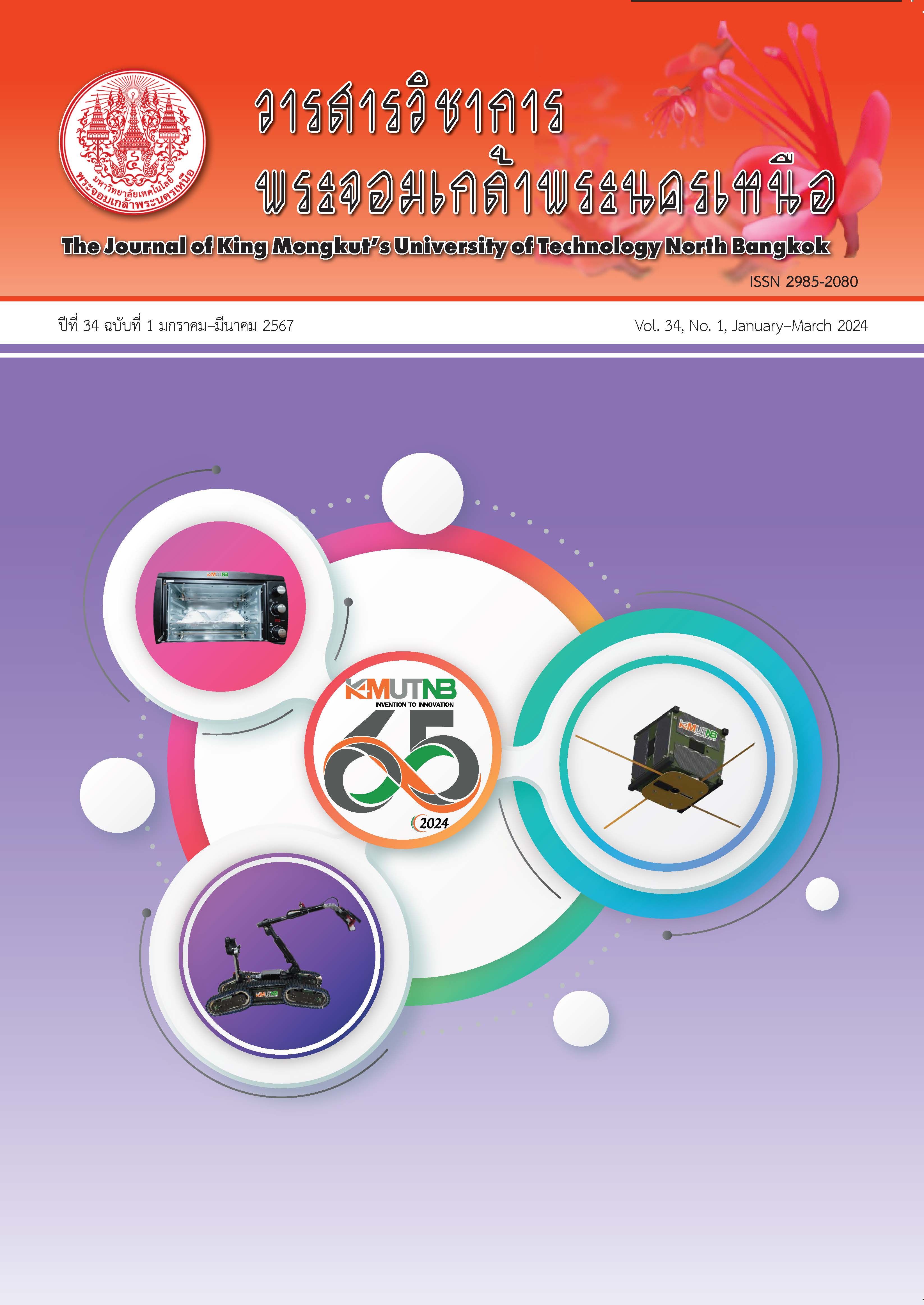การสังเคราะห์ผงผลึกแม่เหล็ก MgFe2O4 ด้วยวิธีการเผาไหม้ของแข็งแบบง่าย โดยใช้อุณหภูมิแคลไซน์ต่ำ
Main Article Content
บทคัดย่อ
งานวิจัยนี้มุ่งเน้นการสังเคราะห์ผงผลึกแมกนีเซียมเฟอร์ไรต์ MgFe2O4 (MF) ด้วยวิธีการเผาไหม้ของแข็งอย่างง่าย โดยใช้ไกลซีนเป็นเชื้อเพลิง ศึกษาผลของอุณหภูมิแคลไซน์ที่มีต่อโครงสร้างผลึก โครงสร้างจุลภาคและสมบัติแม่เหล็กของผงผลึกแมกนีเซียมเฟอร์ไรต์ การตรวจสอบโครงสร้างผลึกของผงผลึกแมกนีเซียมเฟอร์ไรต์แคลไซน์ที่อุณหภูมิ 500–800 องศาเซลเซียส เป็นเวลา 2 ชั่วโมง ด้วยใช้เทคนิคการเลี้ยวเบนของรังสีเอกซ์ (X-ray Diffraction Technique; XRD) พบว่า ผงผลึกแมกนีเซียมเฟอร์ไรต์ทุกตัวอย่างแสดงโครงสร้างสปิเนล แบบคิวบิก และที่อุณหภูมิแคลไซน์ 500 องศาเซลเซียส เป็นเวลา 2 ชั่วโมง พบเฟสสารแปลกปลอมของ Fe2O3 ปรากฏขึ้นในผล XRD สำหรับผงผลึก แมกนีเซียมเฟอร์ไรต์ แคลไซน์ที่อุณหภูมิ 550–800 องศาเซลเซียส เป็นเวลา 2 ชั่วโมง ผงผลึกแสดงโครงสร้างสปิเนลแบบคิวบิกที่บริสุทธิ์ และแสดงค่าร้อยละความบริสุทธิ์ของโครงสร้างสปิเนลแบบคิวบิกเป็น 100 เปอร์เซ็นต์ โครงสร้างจุลภาคของผงผลึกแมกนีเซียมเฟอร์ไรต์แคลไซน์ที่อุณหภูมิระหว่าง 500–800 องศาเซลเซียส เป็นเวลา 2 ชั่วโมง แสดงลักษณะค่อนข้างกลมและเกาะกลุ่มกัน ขนาดอนุภาคเฉลี่ยของผงผลึกมีขนาดเพิ่มขึ้นจาก 122 ± 31 ถึง 310 ± 85 นาโนเมตร เมื่ออุณหภูมิแคลไซน์เพิ่มขึ้นจาก 500–800 องศาเซลเซียส จากการตรวจสอบสมบัติแม่เหล็กที่อุณหภูมิ 300 เคลวิน พบว่า ผงผลึก แมกนีเซียมเฟอร์ไรต์ ที่แคลไซน์ที่อุณหภูมิ 650 องศาเซลเซียส เป็นเวลา 2 ชั่วโมง แสดงสมบัติแม่เหล็กเฟร์โรอิเล็กแบบอ่อนที่ดีที่สุด และแสดงค่าแมกนีไตเซชันอิ่มตัว (Ms ~39.37 emu/g) และค่าแมกนีไตเซชันคงค้าง (Mr ~8.83 emu/g) สูงที่สุด ขณะที่ค่าสนามแม่เหล็กลบล้างมีค่าต่ำ (Hc ~69 Oe) ดังนั้นผลลัพธ์ในงานวิจัยนี้มีความสำคัญอย่างยิ่งต่อการพัฒนาผงผลึก แมกนีเซียมเฟอร์ไรต์ เฟร์โรแมกเนติกเพื่อนำไปใช้ในอุปกรณ์ไมโครอิเล็กทรอนิกส์
Article Details

อนุญาตภายใต้เงื่อนไข Creative Commons Attribution-NonCommercial-NoDerivatives 4.0 International License.
บทความที่ลงตีพิมพ์เป็นข้อคิดเห็นของผู้เขียนเท่านั้น
ผู้เขียนจะต้องเป็นผู้รับผิดชอบต่อผลทางกฎหมายใดๆ ที่อาจเกิดขึ้นจากบทความนั้น
เอกสารอ้างอิง
C. S. Xavier, R. A. Candeia, M. I. B. Bernardi, S. J. G. Lima, E. Longo, C. A. Paskocimas, L. E. B. Soledade, A. G. Souza, and Ida M. G. Santos “Effect of the modifier ion on the properties of MgFe2O4 and ZnFe2O4 pigments,” Journal of Thermal Analysis and Calorimetry, vol. 87, no. 3, pp. 709–713, 2007.
M. Ismael, E. Elhaddad, D. H. Taffa, and M. Wark “Synthesis of phase pure hexagonal YFeO3 perovskite as efficient visible light active photocatalyst,” Catalysts, vol. 7, no. 11, pp. 326–339, 2017.
S. K. Pradhan, S. Bid, M. Gateshki, and V. Petkov “Microstructure characterization and cation distribution of nanocrystalline magnesium ferrite prepared by ball milling,” Materials Chemistry and Physics, vol. 93, pp. 224–230, 2005.
P. Thawong, N. Punlek, S. Pinitsoontorn, and T. Bongkarn, “Effect of the firing temperature on the phase formation, dielectric and ferromagnetic properties of CZFMO ceramics fabricated by the solid-state combustion technique,” Ferroelectrics, vol. 552, no. 1, pp. 10–22, 2019.
C. S. Xavier, R. A. Candeia, M. I. B. Bernardi, S. J. G. Lima, E. Longo, C. A. Paskocimas, L. E. B. Soledade, A. G. Souza and I. M. G. Santos “Effect of the modifier ion on the properties of MgFe2O4 and ZnFe2O4 pigments,” Journal of Thermal Analysis and Calorimetry, vol. 87, no. 3, pp. 709–713, 2007.
D. Chen, D. Y. Li, Y. Z. zhang, and Z. T. Kang, “Preparation of magnesium ferrite nanoparticles by ultrasonic wave-assisted aqueous solution ball milling” Ultrasonics Sonochemistry, vol. 20, no. 6, pp. 1337–1340, 2013.
M. Manikandan, P. Manimuthu, and C. Venkateswaran “Structural and Magnetic properties of MgFe2O4 ceramic,” in AIP Conference Proceedings 1576, 2014, pp. 194–196.
I. S. Hussein, A. S. Elkady, M. M. Rashad, A. G. Mostafa, and R. M. Megahid, “Structural and magnetic properties of magnesium ferrite nanoparticles prepared via EDTA-based sol–gel reaction,” Journal of Magnetism and Magnetic Materials, vol. 379, no. 15, pp. 9–15, 2015.
F. Naaz, H. K. Dubey, C. Kumari, and P. Lahiri, “Structural and magnetic properties of MgFe2O4 nanopowder synthesized via co precipitation route,” SN Applied Sciences 2, vol. 808, 2020.
C. Kornphom and T. Bongkarn, “The effect of firing temperatures on phase evolution, microstructure, and electrical properties of Ba (Zr0.05Ti0.95) O3 ceramics prepared via combustion technique,” Materials Science (MEDŽIAGOTYRA), vol. 20, no. 4, pp. 479–484, 2014.
C. Kornphom, N. Vittayakorn, and T. Bongkarn “Lead-free piezoelectric ceramics based on (1-x)BNKLLT-BCTZ binary solid solutions synthesized by the solid-state combustion technique” Journal of Materials Science, vol. 51, pp. 4142–4149, 2016.
C. Kornphom, S. Yotthuan, P. Kidkhunthod, and T. Bongkarn “Stabilization of the morphotropic phase boundary in (1- x) BNT-xBCTS ceramics prepared by the solid-state combustion technique” Radiation of Physics and Chemistry, vol. 188, 2021.
A. Franco Jr., T. E. P. Alves, E. C. de O. Lima, E. da S. Nunes, and V. Zap, “Enhanced magnetization of nanoparticles of MgxFe(3 − x) O4 (0.5 ≤ x ≤ 1.5) synthesized by combustion reaction,” Applied Physics A, vol. 94, pp. 131–137, 2009.
A. Ruys, Processing, structure, and properties of alumina ceramics, Alumina Ceramics, Woodhead Publishing Series in Biomaterials, 2019, pp. 71–121.

